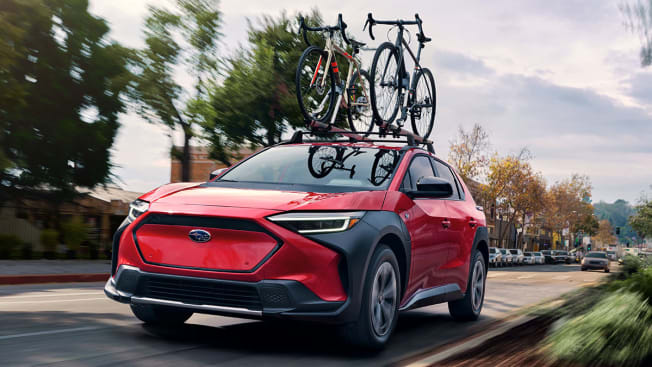The Words You Need to Know Before You Buy a Hybrid, EV, or PHEV
This glossary will prepare you for the new world of electrified vehicles
If you’ve been shopping for an electric car, hybrid, or plug-in hybrid, you’ve probably come across some words you might be unfamiliar with, even if you already know a lot about cars.
- The Words: Before You Buy Charging Driving

Photo: Ford Photo: Ford
Before You Buy
ICE: Internal combustion engine. This is the gas-burning engine in a traditional vehicle. Hybrids and PHEVs also have internal combustion engines.
Mild hybrid: In most cases, this is essentially a larger alternator that can provide a small amount of electric assist to the gas engine. The system allows the engine to turn off while coasting to save fuel and the auto stop/start system can keep the engine off longer at stop lights. You won’t notice any electric-only propulsion as in a traditional hybrid, and the fuel economy benefit is smaller. Many are advertised as having 48V electrical systems.
Hybrid: Hybrids combine a gasoline engine and an electric motor powered by a large battery. With most hybrids, the electric motor drives the car for short distances when less power is needed, such as creeping along in traffic, parking, or coasting on the highway. The gas engine kicks in when accelerating, going up a steep hill, or in cold weather. Hybrids don’t have to be plugged in because the gas engine recharges the car’s battery, as do regenerative brakes that capture momentum to create electricity as the car slows down or coasts.
PHEV: Plug-in hybrid electric vehicle. They work like conventional hybrids but can also be plugged into a wall outlet or EV charger to charge the battery for an additional 20 to 50 miles of all-electric range. Once the charge runs out, a PHEV drives like a hybrid and can be filled up at any gas station. But they have to be plugged in as much as possible for you to see cost and fuel economy benefits.
EV: Electric vehicle, otherwise known as a battery electric vehicle (BEV). Fully electric vehicles don’t have a gasoline engine. Instead, they have an electric motor that’s powered by a large battery, which must be charged. All-wheel-drive versions have at least two electric motors, one for driving the front wheels and one for driving the rear. Total range is typically less than hybrids and gas cars, and long trips can require long stops at public charging stations.
kW: Kilowatt, or one thousand watts, the unit for electrical power. For EVs, it’s used to express the maximum acceptance rate at public DC fast-charging places, the power output of an onboard charger, or the power output of an electric motor (which can be converted to horsepower).
kWh: Kilowatt hour. A unit of energy that’s stored inside a battery, expressing the battery’s capacity. Think of a battery’s kWh capacity as the equivalent of how many gallons of gas a tank can hold.
MPGe: Miles per gallon equivalent. Used to estimate the equivalent energy use of PHEVs and EVs to compare with cars without plugs. It’s not the same as a PHEV’s gas-only mpg.
mi/kWh: Miles per kilowatt hour. The EV version of MPG, this is miles traveled per unit of energy (kWh) in the battery. A higher number means greater efficiency. Typical numbers range between 2.0 and 4.0 mi/kWh.
Gas-only mpg: The gas mileage a PHEV gets when its battery is spent.
All-electric range (AER): The electric range of either a PHEV or an EV. CR does its own tests of EV range at highway speeds, which can tell you how long you have between charges on a road trip.
SOC: The battery state of charge. Think of it as similar to the battery level on your phone.

Photo: Nissan Photo: Nissan
Charging an EV or PHEV
Miles of range per hour/per minute: How quickly an EV or a PHEV can add electric miles while charging. (It can sometimes be abbreviated as MPH, which is better known as the abbreviation for miles per hour.) A vehicle that can fill its battery quickly and is also efficient will add the most miles during its time charging.
EVSE: Electric vehicle supply equipment. Most people call it a charger. It’s the wall-mounted or stand-mounted connector that supplies 240-volt power to an EV.
Level 1 charger: A 120-volt charger. Many EVs and PHEVs come with a mobile charging cable that fits a regular household outlet on one end and has a coupler that plugs into the car at the other end. It can add about 3 to 5 miles of range per hour of charging. This can be enough for a PHEV but is best used as a last resort for an EV.
Level 2 charger: A 240-volt charger that can be installed at home or in public. It adds 20 to 40 miles of charge per hour and can fully charge an EV’s battery overnight. Public versions can be free or cost money depending on the location and provider.
Level 3/DC fast charger: A public charger that can add about 150 miles or more to an EV’s battery in 30 minutes. They usually cost money to use and aren’t as common as Level 2 chargers. Common fast charging networks include Tesla’s Superchargers, Electrify America, EVGo, and Chargepoint.
Onboard charger: An internal device built into EVs that converts alternating current from a Level 1 or Level 2 charger into direct current that can charge an EV’s battery. It’s typically bypassed during DC fast charging.
Charging acceptance rate/max acceptance rate: The maximum amount of power (measured in kW) that an EV can accept while charging. Vehicles with lower charging acceptance rates will add miles of range more slowly than similarly efficient vehicles with higher acceptance rates and might not benefit from the most powerful DC fast chargers. For example, a vehicle with a 180 kW acceptance rate won’t charge any faster than 180 kW if you plug into a 350 kW DC fast charger. But it will charge faster than a vehicle with a 150 kW acceptance rate. This is helpful to know when searching for the quickest public charging option or when selecting a compatible level 2 charger for your home.

Illustration: Chris Philpot Illustration: Chris Philpot
Type 1 connector: Also called J1772, this is a type of charger plug used on many American and European EVs and PHEVs that aren’t made by Tesla. Used at Level 1 and 2 chargers.
CCS (Combined Charging Standard) connector: A type of charger plug that combines a J1772 plug with an additional section that’s used for DC fast charging on many American and European EVs and PHEVs that aren’t made by Tesla.
NACS (North American Charging Standard) connector: Also called J3400, this is a combination AC/DC charging plug used on Tesla vehicles that’s being introduced on EVs from other brands. Adapters exist to convert between NACS and CCS.
CHAdeMO connector: A type of DC fast-charging plug used on the Nissan Leaf and some older Mitsubishi models in the U.S. The name is based on the abbreviation for the French phrase “charge de move” (“charge for moving”) and the Japanese phrase “O cha demo ikaga desuka,” (“let’s have a cup of tea while charging”).
Starter battery: A small, replaceable 12V battery used to start and run accessory features on hybrids, PHEVs, and many EVs. It’s similar to a traditional car battery found on an ICE vehicle.
Drive battery: Also called a high-voltage battery, it’s a large battery that can drive an electric motor in a hybrid, PHEV, or EV. It’s not present on an ICE vehicle.
DC-DC Converter: It steps down the higher voltage in an EV’s drive battery for running lower voltage accessories and components.

Photo: Chevrolet Photo: Chevrolet
Driving
Regenerative brakes: Capture momentum to create electricity as the car slows down or coasts. Used on hybrids, PHEVs, and EVs.
One-pedal driving: Using regenerative brakes, the driver can speed up, slow down, and bring the vehicle to a complete stop just by modulating the accelerator pedal.
Route planning: The process and technology to help find public chargers when taking an EV on a long trip. The built-in navigation systems on many EVs can automatically add charging stops along a route and tell the driver how long they will spend there. Many smartphone apps, including A Better Route Planner, can do this as well. Apps such as PlugShare can help you search for individual chargers, and apps from charging networks such as Electrify America can tell you if those chargers are occupied.
Preconditioning: When an EV is plugged in, it uses power from the grid to warm up or cool an EV’s cabin before driving. Can often be preset or controlled remotely using an app. This can help preserve range.
Battery preconditioning: The vehicle warms up or cools its battery for optimal DC fast-charging speeds. Often triggered by setting the built-in navigation system to a charger. Can also be activated manually in some vehicles.
Heat pump: Standard in many EVs, it’s an efficient device that heats the cabin and battery by drawing warm air from the outside, even in cold temperatures. Because EVs don’t have internal combustion engines, they can’t warm the cabin using heat produced by the engine as a gas-powered car or hybrid can.
Battery management system (BMS): Adjusts charging and monitors battery usage to preserve battery life and optimize charging speed.






















